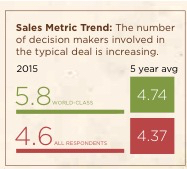Do you ever feel like your deals are heading down the track toward success, but then somehow end up not closing and falling apart? What is happening between point A and point B? What is derailing your deals? In part two of this mini-series, we are going to look at another common issue that causes deals to miss the mark:
- Wrong Buyer Profile
- Unqualified Buyer
- Status Quo Wins
- Me-Too Positioning & Messaging
- No Value Proposition
Unqualified Buyer
The same expression used in part 1 “barking up the wrong tree”, could also be applied to this issue, but with a very important twist… While the ideal buyer profile provides some guideposts for where marketing and sales should direct their resources, ultimately the selling organization must decide if the lead demands further investment. Making this judgment is a common angst that arises not only between the marketing and sales teams in “lead hand-off”, but also between sales management and field sales professionals. The determination of whether a lead — and further in the sales cycle, a pursuit — is qualified or not can often be determined by examining four simple factors.
A lead is qualified when, and only when, it meets all four of the following criteria:
1) The Problem is One You Can Solve: The target organization and buying audience must have an issue related to a fundamental problem the selling organization can solve. In some scenarios, the buyer may not even recognize that it has a problem yet, but the selling organization’s marketing and/or sales teams know that the symptoms they (and hopefully the prospect) are witnessing are clear indicators of an underlying problem their solution addresses.
2) Charter Exists to Solve the Problem: The buying audience must have both the budget and authority to solve the problem. In too many cases the deal is doomed from the beginning because the buying organization does not have a budget assigned. This is not always a “go/no-go” sign, as long as the prospective buyer has the ability to create the budget — often by shifting resources earmarked for another initiative to this one. The mirror image of this in today’s procurement-laden buying cycles is a buyer who has the budget, but does not have the authority to invest that budget. While the budget is allocated to them, a senior member of the organization — the CFO, for example — can step in and repurpose that budget for other means or shut down the budget all together. This does not necessarily mean that the CFO, in this case, is your buyer, it just means that you have to bring forth a compelling value proposition for that investment. (More on that later in this series.)
3) Decision Maker has a Sense of Urgency: While your buying audience, and the decision maker in particular, may have the charter to solve the problem (both the budget and authority), they may not have a compelling timeline to do so. For some buyers this is as simple as them not believing the problem is big enough RIGHT NOW to address. There may be more pressing matters vying for their attention and the resources under their control. For other buyers, the selling organization has not yet struck a chord with the buyer’s personal pains. While business and financial pains are fundamental to making a compelling case to address the problem, the marketing and sales teams of the seller still have to embrace the fact that every business decision a buyer makes (on behalf of their organization) is grounded in the personal downside/upside quotient. Sellers who fail to activate the personal pains of their buying audiences do so at the risk of their own peril.
4) Decision Maker will Take a Meeting: In today’s “committee” buying decisions, there is often a multitude of people involved in the purchase process. In fact, CSO Insights surveys of buying and selling organizations have shown a trend to more and more players involved in the buying committee.

(Source: 2015 CSO Insights/MHI Research Institute Sales Best Practice Study)
While the roles and responsibilities of these players vary, there are often 1) “researchers” doing the initial exploration on solutions, 2) “recommenders” who dive-deeper into those solutions and their applicability for the buying organization and/or 3) “reviewers” who take the research and recommendations into account — as well as their past experiences and expertise — to reach a conclusion. When all three of these constituents come together as a committee, some of the roles can blur, but all three are present to varying degrees.
As the selling organization, it is imperative to secure a meeting (preferably face-to-face for more sophisticated solutions) with all members of this buying trio in order to activate their business, financial and personal pains directly. This also allows a selling team to deliver the differentiated value proposition of the solution to the buyer’s problem. As a general rule, when a selling organization is unable to garner those meetings, red flags should be going up that the lead/opportunity is not qualified.
The most direct, and often simplest, manner to qualify a lead is to have a brief conversation with the prospect about the problem. Most importantly, if the lead is not qualified, discontinue active engagement with the lead, or identify the appropriate means of nurturing the lead through a more scalable investment of time and dollars.
Making sure the lead you are pursuing meets all four of the these criteria will keep you from wasting time chasing after unqualified buyers. How well are you applying this filer in your lead qualification efforts? Are there any criteria you would add to this list?
